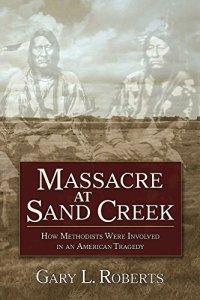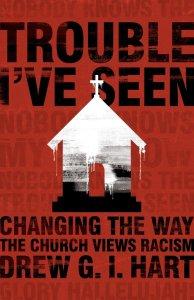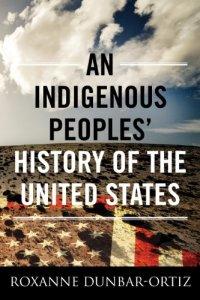By Charles Kiker
In recent weeks I have read three disturbing books:
 Massacre at Sand Creek: How Methodists Were Involved in an American Tragedy, published by Abingdon Press. The author, Gary L. Roberts is Emeritus Professor of History at Abraham Baldwin College in Tifton, Georgia. He is a respected historian of the American West and has written extensively regarding frontier violence;
Massacre at Sand Creek: How Methodists Were Involved in an American Tragedy, published by Abingdon Press. The author, Gary L. Roberts is Emeritus Professor of History at Abraham Baldwin College in Tifton, Georgia. He is a respected historian of the American West and has written extensively regarding frontier violence;
Trouble I’ve Seen: Changing the Way the Church Views Racism, by Drew G. I. Hart. Dr. Hart earned his PhD in theology and ethics from Lutheran Theological Seminary, and is Assistant Professor at Messiah College; and
An Indigenous Peoples’ History of the United States, by Roxanne Dunbar-Ortiz, daughter of a tenant farmer in rural Oklahoman and a half Indian mother. She is a long term participant in the International Indigenous movement and is committed to social justice issues.
These books have several things in common: they are all disturbing, at least to this son of white privilege, and should be disturbing to any knowing recipient of white privilege. To unknowing recipients, perhaps they will ring an alarm bell awakening them to racial injustice and provoking them to action.
All three books emphasize the pervading sense of white superiority common to our ancestors in the white world, and following their descendants into the “New World,” and how the “Doctrine of Discovery” and the “Right of Conquest” went hand in hand with the sense of white superiority.
And all three rue the social injustice accompanying the sense of white superiority.
I was aware that there was a massacre at Sand Creek before reading the book, but not of the details of the historical, military, and political/ecclesiastical contexts as Professor Roberts illuminates them.
Colonel John Chivington, a Methodist preacher turned soldier, led the expedition against the Indians at Sand Creek in southeastern Colorado in 1864. Those in the camp when the expedition arrived were largely old people, women and children. “Kill them all. Nits grow up to be lice,” had been a saying regarding the natives in the Indian wars. So indiscriminate killing of women and children was nothing new at Sand Creek. But mutilation of corpses was not officially countenanced in the U. S. military. The soldiers in the expedition were enthusiastically welcomed when they rode back into Denver with their human trophies, including both male and female genitalia, and fetuses carved out of slain mothers. The expedition was never officially condemned by the Methodist church.
And in 1893, Methodist-supported Iliff School of Theology came into possession of a copy of a tome of church history bound in the hide of a murdered Native American. The book was on display at Iliff until 1974, when it was removed and the hide sent back east for proper burial at the insistence of a group of theology students in cooperation with the American Indian Movement. The board and administration at Iliff sought to keep the matter hush-hush. (See Massacre at Sand Creek, pp. 243-245).
 In the opening pages of Trouble I’ve Seen, Drew Hart describes an incident with his family. Drew was vacationing with friends in Washington State when he got a call from his mother concerning his brother. A crime had been committed. His brother fit the eye-witness description of a crime that had been committed by a “black male with a black T-shirt and blue jeans.” Furthermore, he had blood on his shirt, blood that under lab analysis proved to be ketchup.
In the opening pages of Trouble I’ve Seen, Drew Hart describes an incident with his family. Drew was vacationing with friends in Washington State when he got a call from his mother concerning his brother. A crime had been committed. His brother fit the eye-witness description of a crime that had been committed by a “black male with a black T-shirt and blue jeans.” Furthermore, he had blood on his shirt, blood that under lab analysis proved to be ketchup.
What if a crime were committed in my home town by a tall elderly balding white man? I’m a tall elderly balding white man. But how many more in the near vicinity fit that description? I might possibly be questioned, but never arrested unless there was much more evidence. I’m a white man. Drew’s brother was a black man wearing a black T-shirt and blue jeans; he was arrested and detained for four months before he was freed for lack of evidence. That was bad but could have been much worse.
The author describes his public schooling in and near Norristown, PA. Bused to a suburban school in elementary school, he was racial minority; in Junior High he walked to a nearby school where he was racial majority. In High School he was Mr. Cool black basketball player.
As he progressed in High School he decided he should answer his call to ministry. After graduation he went to a nearby Christian college where there were few black faces. At first he felt totally isolated. Students would move to the other side when meeting a black person on the sidewalk. As he became accepted, he became aware that he was a “good black,” not like the others. He writes:
The ongoing racial prejudice on campus was more persistent and life draining than anything I had seen in my life. Nothing, including the black church I had grown up in, had prepared me for white Christian community. . . . As I reflect on my college experience, I’m left with the fact that this mostly white Christian college was a more racially hostile and antagonistic space than Norristown, in which different racial and economic groups had their lives structured together. It was also more draining for me than the mostly white suburban school. How could that be? How could my time among white Christians have been more painful for me as a young black male than my time among white non-Christians (pp. 41-42).
But he was a Biblical Studies major grasping a vision of a new humanity where barriers were being broken down, and even though his Christian college community did not reflect this way of life, he caught a vision of God who in Jesus Christ is birthing true justice, true shalom.
Dr. Hart concludes his book by relating an incident when he was stopped by police late at night. He remembered that many of his black brothers and sisters had died as a result of a traffic stop. Another police car arrived and shined his bright headlights into the car. He saw two policemen approaching his car on the left and right, guns drawn. He had no idea why they had stopped him, and learned that his registration sticker had expired. After questioning him, one of them wrote him a citation for the expired registration, and he was allowed to go on, glad to be alive.
I have been stopped by police several times for traffic violations. I have never had police approach with guns drawn. But then, I am not black. I am a recipient of white privilege just because and only because I am white.
 In An Indigenous Peoples’ History of the United States Roxanne Dunbar Ortiz traces the story of conquest, violence, and dehumanization of the indigenous peoples from the time of the first white settlers on the American continents to the end of the Indian wars, and beyond to the American Empire with American troops worldwide. At the conclusion of her book, (p. 235) she asks, “How then can US society come to terms with its past? How can it acknowledge responsibility?” She allows the late Native historian Jack Forbes to answer, “[W]hile living persons are not responsible for what their ancestors did, they are responsible for the society they live in, which is a product of that past.”
In An Indigenous Peoples’ History of the United States Roxanne Dunbar Ortiz traces the story of conquest, violence, and dehumanization of the indigenous peoples from the time of the first white settlers on the American continents to the end of the Indian wars, and beyond to the American Empire with American troops worldwide. At the conclusion of her book, (p. 235) she asks, “How then can US society come to terms with its past? How can it acknowledge responsibility?” She allows the late Native historian Jack Forbes to answer, “[W]hile living persons are not responsible for what their ancestors did, they are responsible for the society they live in, which is a product of that past.”
I am not responsible FOR my great-great-great-grandfather Henry deeding, in 1821, a 13 year old slave girl called Fanny to his son Edward, “to have and to hold” in the language of the deed. I am responsible, TO my children and their children and their children’s children, to do all I can and to try to persuade others to do all they can to create a more just society and a more shalom-filled world for the future of the human race and of the planet on which our progeny shall dwell.
Dr. Charles Kiker is a retired minister and a founding member of Friends of Justice
